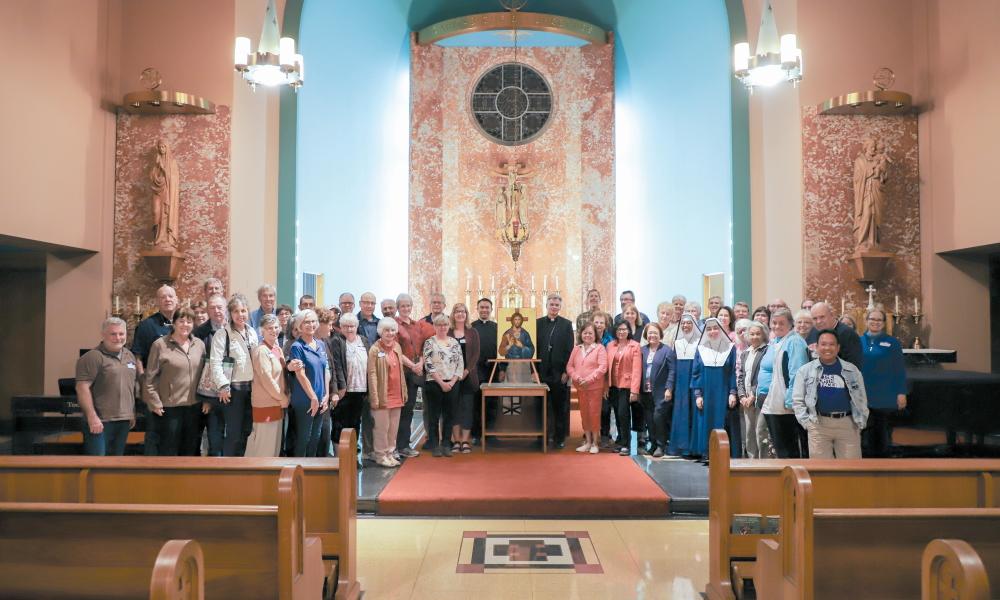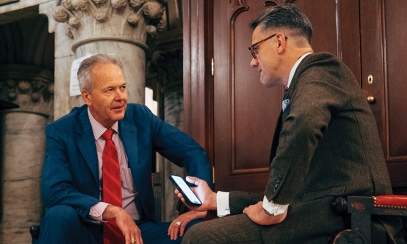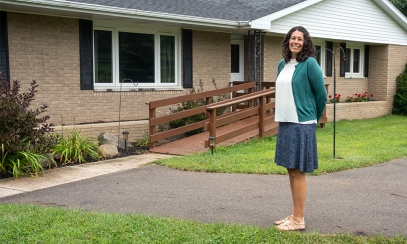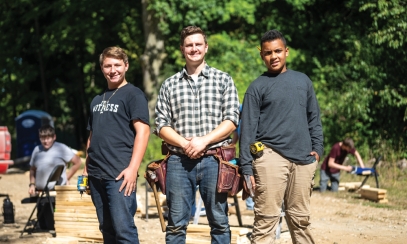
On the Way
Diocesan Pilgrimage of the Sacred Heart
Diocesan Pilgrimage of the Sacred Heart
Boarding a bus at 5:30 in the morning is not normally enjoyable, yet, as I set foot on the prayer pilgrimage bus, or motor coach as our driver called it, the air seems to pulse with a subtle excitement. Gathered with more than 50 fellow Catholics, including one woman spending her first day of retirement on pilgrimage, we set off from Providence Sacred Heart Medical Center in Spokane.
Brian Kraut, diocesan director of evangelization, introduced our journey as we cruised north on Division. Only a few miles in, we began praying the Rosary and the day was off and running. From Spokane, the pilgrims set out for Kettle Falls, followed by a trek over Sherman Pass to Nespelem on the Colville Reservation. Brewster, near the far western edge of the diocese, was our next stop before heading to Wilbur and returning to Sacred Heart Medical Center. At each stop, we were alive with prayer, filled with joy and generous in hospitality.
Welcome
In Kettle Falls, the Catholic Daughters of the Americas Court welcomed us, along with seminarian Jef Lant, to a wonderful breakfast. After conversation and food, the pilgrims went into the Church of the Sacred Heart to pray a Chaplet of Divine Mercy. This scene repeated itself at each stop: welcome, food and prayer. Pilgrim Al Oliva said, “I felt overwhelming joy at being received so warmly by perfect strangers. ... I saw the face of Christ in them. I only hope they also saw the face of Christ in me.”
In Nespelem, a bountiful lunch greeted the travelers; the hosts waited to eat until their guests finished. In Brewster, the parishioners showed Christ-like hospitality by forming a line to shake each pilgrim’s hand before offering an unexpected meal. In Wilbur, despite the pilgrims’ late arrival, a sumptuous parish potluck awaited them. Ellen Davis reflected on the pilgrimage, “What I experienced was love and generosity at each of these parishes through their warm welcoming smiles, a loving hug, conversation and wonderful abundant meals they provided.”
Davis’ insight into the love of Christ she experienced was more than mere hospitality, but a call “to experience the love of Jesus, I must show and give love to others through giving of myself in my parish. It was a wonderful experience and I have a new understanding of the Sacred Heart of Jesus and his unconditional love for us.” Many pilgrims agreed that the communities’ love poured out all along the way witnessed Christ’s love to them.
Prayer
Throughout each day, we met again and again in prayer – in churches and on the bus. We prayed the Rosary early in the morning, followed by a sixth decade for vocations as our Bishop often asks of us, and the Chaplet of Divine Mercy before departing Kettle Falls. As the bus climbs up Sherman Pass, Brian Kraut distributes photos of each priest in the diocese, asking each pilgrim to pray for one particular priest. In a bit of divine coincidence, I was able to pray for my newly appointed pastor. I think each pilgrim felt privileged to pray for a priest’s ministry. On another leg of the journey, pilgrims prayed for a parish community.
We witnessed two profound moments of prayer at Mass and in a guest worker camp. In Nespelem, the community’s love for and pride in the liturgy shined forth. The joyous Mass blended modern Catholicism with Native traditions. Worshipers experienced the tradition of Smudge incense during the Eucharistic prayer, uniting Native tradition with the Church’s liturgical worship.
In Brewster, after a warm welcome, we traveled to a guest laborers camp for workers on H-2A visas. We planned to pray the Rosary for camp residents and all those who seek a better life in the U.S. and we weren’t sure what to expect. As we prayed the Rosary, alternating decades in English and Spanish, more and more men came out to pray with us. Many pilgrims will attest that this ordinary prayer became extraordinary. The camp filled with a deep sense of communion with our brothers and sisters in Christ. As many of us gave our rosaries to the workers, I would say that we, the pilgrims, received more.
History
A stop at historic St. Paul’s Mission Church outside of Kettle Falls gave us insight into the Church’s early years in our region. The simple structure hewn from the forest and daubed with mud to fill the gaps between timbers still stands. Charlie McGuire was struck by the building, “The persons who built this mission created something that lasted beyond themselves. ... I could sit in St. Paul’s Mission for hours and just imagine the people who crafted it. They loved the Lord. This mission building is a labor of love.”
“A labor of love” describes the food, the churches and the communities we encountered. One particular example is the small cemetery near Sacred Heart Parish in Nespelem. We often think of green lawns and manicured gardens, but, in so many ways, this cemetery’s simplicity made it more beautiful. Near the entrance was the gravesite of Chief Joseph, a Nez Perce leader who resisted the forced removal of his people from their historic lands. In his later life, Chief Joseph became known for his humanitarian efforts for Native American communities.
Gratitude and Ongoing Prayer for Vocations
Joan DeGroot spoke with awe about our priests, especially those covering unending miles in rural assignments. “Meeting and speaking to the priests assigned to these remote locations, I was struck by their unending devotion to their vocation. Men who spend long hours covering miles each day to share the Mass, funerals, weddings and baptism with other Catholics. Traveling all day Sunday, celebrating Mass with the assigned commitments, journeying home late in the day.” The commitment of our priests was clear as we visited these vibrant rural parishes, as was the commitment of the parishioners. The Church in Nespelem is alive because of the community. One parishioner joined us for Mass simply because he saw the crowd and thought it worthwhile to be with the community.
As we saw both joy and need in these rural communities (and in our city parishes as well), we discovered that praying to the harvest-master to send laborers is especially meaningful. For the harvest is great and the laborers are few (cf. Mt. 9:36-37). DeGroot also commented, “Bishop Daly has asked us to say an extra decade of the Rosary for an increase of vocations. ... This now has an urgency and a visual example of how important this request is. I will now keep in mind these blessed priests and ask God to guide His selected flock to join in this urgent endeavor, and I ask you to do the same.”
Ending the day with Bishop Daly in the Providence Sacred Heart Medical Center Chapel seemed especially fitting after touring the northern end of the Diocese and praying for our parishes and our pastors. Pilgrims saw with their own eyes the work of the Sacred Heart in the life of our Diocese, in the priests who seek to be like Christ and in communities where the love of Jesus is manifest.



